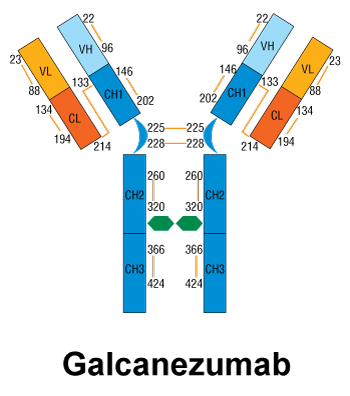SUMMARY CMI
EMGALITY®
Consumer Medicine Information (CMI) summary
The full CMI on the next page has more details. If you are worried about using this medicine, speak to your doctor or pharmacist.
1. Why am I using EMGALITY?
EMGALITY contains the active ingredient galcanezumab. EMGALITY is used to prevent migraine in adult patients. For more information, see Section 1. Why am I using EMGALITY? in the full CMI.
2. What should I know before I use EMGALITY?
Do not use if you have ever had an allergic reaction to EMGALITY or any of the ingredients listed at the end of the CMI.
Talk to your doctor if you have any other medical conditions, take any other medicines, or are pregnant or plan to become pregnant or are breastfeeding. For more information, see Section 2. What should I know before I use EMGALITY? in the full CMI.
3. What if I am taking other medicines?
Some medicines may interfere with EMGALITY and affect how it works. A list of these medicines is in Section 3. What if I am taking other medicines? in the full CMI.
4. How do I use EMGALITY?
- The recommended starting dose of EMGALITY is 240 mg (two 120 mg injections) by subcutaneous injection. After the first dose, use 120 mg (one injection) every month.
- EMGALITY should be used at about the same time each month to have the best effect.
- More instructions can be found in Section 4. How do I use EMGALITY? in the full CMI.
5. What should I know while using EMGALITY?
| Things you should do |
|
| Things you should not do |
|
| Driving or using machines |
|
| Drinking alcohol |
|
| Looking after your medicine |
|
For more information, see Section 5. What should I know while using EMGALITY? in the full CMI.
6. Are there any side effects?
Injection site reactions (e.g., red skin, pain), vertigo (a feeling of dizziness or 'spinning'), constipation, itching, and rash were commonly reported in patients using EMGALITY. These side effects are usually mild and short-lived. Other side effects may include fatigue. Serious side effects may include sudden signs of allergy such as rash, itching, hives on the skin, swelling of the face, lips, tongue or other parts of the body, shortness of breath, wheezing or trouble breathing. Although allergic reactions usually seen with EMGALITY are mild to moderate, it is possible that more serious reactions could occur.
For more information, including what to do if you have any side effects, see Section 6. Are there any side effects? in the full CMI.
FULL CMI
EMGALITY® (em-GAL-it-ē)
Active ingredient(s): galcanezumab
Consumer Medicine Information (CMI)
This leaflet provides important information about using EMGALITY. You should also speak to your doctor or pharmacist if you would like further information or if you have any concerns or questions about using EMGALITY.
Where to find information in this leaflet:
1. Why am I using EMGALITY?
2. What should I know before I use EMGALITY?
3. What if I am taking other medicines?
4. How do I use EMGALITY?
5. What should I know while using EMGALITY?
6. Are there any side effects?
7. Product details
1. Why am I using EMGALITY?
EMGALITY contains the active ingredient galcanezumab, a humanised monoclonal antibody that stops the activity of a naturally occurring substance in the body called calcitonin gene-related peptide (CGRP). People with migraine may have increased levels of CGRP.
EMGALITY is used to prevent migraine in adult patients.
Migraine is a disease affecting the nervous system where patients suffer with repeated headaches, often only affecting one side of the head. The headaches are commonly associated with feeling nauseous, or vomiting, and patients can also be very sensitive to light and sound.
The active ingredient in EMGALITY is galcanezumab. Galcanezumab belongs to a group of preventative medicines that stop the activity of a naturally occurring substance in the body called calcitonin-gene-related peptide (CGRP). Increased levels of CGRP have been associated with migraine.
EMGALITY has been shown to improve quality of life by significantly reducing the frequency of migraine headache. It starts working in about a week.
2. What should I know before I use EMGALITY?
Warnings
Do not use EMGALITY if:
- You are allergic to galcanezumab, or any of the ingredients listed at the end of this leaflet.
- Always check the ingredients to make sure you can use this medicine.
- The packaging is torn or shows signs of tampering.
- The expiry date on the pack has passed.
Check with your doctor if you:
- Have any other medical conditions, allergies to any other medicines, foods, preservatives, or dyes.
- Are pregnant, plan to become pregnant, or are breastfeeding. Your doctor will discuss the risks and benefits involved.
- Are taking any other medicines, including those you get without a prescription from your pharmacy, supermarket, or health food shop.
During treatment, you may be at risk of developing certain side effects. It is important you understand these risks and how to monitor for them. See additional information under Section 6. Are there any side effects?
Pregnancy and breastfeeding
Check with your doctor if you are pregnant or intend to become pregnant.
Talk to your doctor if you are breastfeeding or intend to breastfeed.
It is preferable to avoid the use of EMGALITY in pregnancy, as the effects of this medicine in pregnant women are not known.
Children and adolescents under 18 years of age
Do not give this medicine to children and adolescents under 18 years of age. EMGALITY has not been studied in this age group.
3. What if I am taking other medicines?
Tell your doctor or pharmacist if you are taking any other medicines, including any medicines, vitamins or supplements that you buy without a prescription from your pharmacy, supermarket or health food shop.
Some medicines and EMGALITY may interfere with each other. Your doctor and pharmacist have more information on medicines to be careful with or avoid while taking this medicine.
Check with your doctor or pharmacist if you are not sure about what medicines, vitamins or supplements you are taking and if these affect EMGALITY.
4. How do I use EMGALITY?
Follow all directions given to you by your doctor or pharmacist carefully.
How much to use
- Each pen and syringe contain one dose of EMGALITY (120 mg). Each pen or syringe delivers only one dose.
- The first dose is 240 mg (two 120 mg injections) given by injection under the skin (subcutaneous injection).
- After the first dose, you will use a 120 mg dose (one injection) every month.
When to use EMGALITY
- Take your medicine at about the same time each month.
- Taking it at the same time each month will have the best effect. It will also help you remember when to take it.
How to use EMGALITY
- Read the "Instructions for Use" for the pen or syringe carefully before using EMGALITY. Comprehensive instructions for administration are given in the Instructions for Use in the package insert.
- EMGALITY is given by injection under your skin (subcutaneous injection). You and your doctor or nurse should decide if you should inject EMGALITY yourself.
- It is important not to try to inject yourself until you have been trained by your doctor, pharmacist, or nurse. A caregiver may also give you your EMGALITY injection after proper training.
- The pen and syringe must not be shaken.
If you forget to use EMGALITY
Do not take a double dose to make up for the forgotten injection when you next inject.
- If you have forgotten to inject a dose of EMGALITY, inject the missed dose as soon as possible and then resume monthly dosing.
- If you are not sure what to do, ask your doctor or pharmacist.
- If you have trouble remembering to take your medicine, ask your pharmacist for some hints.
If you use too much EMGALITY
If, after the initial dose of 240 mg, you have injected twice in a single monthly period, then you should inform your doctor.
You should immediately:
- phone the Poisons Information Centre
(by calling (Australia) 13 11 26 (New Zealand) 0800 764 766), or - contact your doctor, or
- go to the Emergency Department at your nearest hospital.
You should do this even if there are no signs of discomfort or poisoning.
5. What should I know while using EMGALITY?
Things you should do
- If you are about to be started on any new medicine, remind your doctor and pharmacist that you are taking EMGALITY.
- If you become pregnant while taking this medicine, tell your doctor immediately.
- Keep all of your doctor's appointments so that your progress can be checked.
Things you should not do
- Do not take EMGALITY to treat any other complaints unless your doctor tells you to.
- Do not give your medicine to anyone else, even if they have the same condition as you.
- Do not stop taking your medicine, or change the dosage, without checking with your doctor.
Driving or using machines
Be careful before you drive or use machines or tools until you know how EMGALITY affects you. Some patients have had vertigo while using EMGALITY.
Drinking alcohol
Tell your doctor if you drink alcohol.
Looking after your medicine
- Keep EMGALITY pens and syringes in a refrigerator (2°C to 8°C).
- EMGALITY can be left out of the fridge for up to 7 days at a temperature not above 30°C. If these conditions are exceeded, then EMGALITY must be thrown away.
- Once EMGALITY has been stored out of refrigeration, do not place it back in the refrigerator
- Do not freeze EMGALITY. Do not use it if it has been frozen.
- Store EMGALITY in the original packaging to protect it from light.
- Do not use a pen or syringe after the expiry date (month, year) stamped on the label.
Follow the instructions in the carton on how to take care of your medicine properly.
Store it in a cool dry place away from moisture, heat or sunlight; for example, do not store it:
- in the bathroom or near a sink, or
- in the car or on windowsills.
Keep it where young children cannot reach it.
When to discard your medicine
Do not use this medicine after the expiry date printed on the pack, if it is damaged, or the packaging is torn or shows signs of tampering.
Getting rid of any unwanted medicine
If you no longer need to use this medicine or it is out of date, take it to any pharmacy for safe disposal.
Do not use this medicine after the expiry date.
6. Are there any side effects?
All medicines can have side effects. If you do experience any side effects, most of them are minor and temporary. However, some side effects may need medical attention.
See the information below and, if you need to, ask your doctor or pharmacist if you have any further questions about side effects.
Less serious side effects
| Less serious side effects | What to do |
Injection site reactions:
| Speak to your doctor if you have any of these less serious side effects and they worry you. |
Serious side effects
| Serious side effects | What to do |
Symptoms of an allergic reaction may include:
| Call your doctor straight away or go straight to the Emergency Department at your nearest hospital if you notice any of these serious side effects. |
Tell your doctor or pharmacist if you notice anything else that may be making you feel unwell.
Other side effects not listed here may occur in some people.
Reporting side effects
After you have received medical advice for any side effects you experience, you can report side effects to the Therapeutic Goods Administration online at www.tga.gov.au/reporting-problems. By reporting side effects, you can help provide more information on the safety of this medicine.
Always make sure you speak to your doctor or pharmacist before you decide to stop taking any of your medicines.
7. Product details
This medicine is only available with a doctor's prescription.
What EMGALITY contains
| Active ingredient (main ingredient) | Galcanezumab |
| Other ingredients (inactive ingredients) | Histidine Histidine hydrochloride monohydrate Polysorbate 80 Sodium chloride Water for injections This medicine does not contain lactose, sucrose, gluten, tartrazine or any other azo dye. |
Do not take this medicine if you are allergic to any of these ingredients.
What EMGALITY looks like
EMGALITY is a solution in a clear glass syringe. Its colour may vary from colourless to slightly yellow.
Prefilled Pen
EMGALITY is a solution in a clear glass syringe. Its colour may vary from colourless to slightly yellow. The syringe is encased in a disposable, single-dose pen. Each pen is for single use only.
Prefilled pens may be available in pack sizes of 1, 2, or 3.
Prefilled Syringe
EMGALITY is a solution in a clear glass syringe. Its colour may vary from colourless to slightly yellow. Each syringe is for single use only.
Prefilled syringes may be available in pack sizes of 1, 2, or 3.
Note: All presentations or pack sizes may not be available.
Australia
- EMGALITY 120 mg/mL prefilled pen: AUST R 302146
- EMGALITY 120 mg/mL prefilled syringe: AUST R 302145
New Zealand
- EMGALITY 120 mg/mL prefilled pen: TT50-10685
- EMGALITY 120 mg/mL prefilled syringe: TT50-10685/1
Who distributes EMGALITY
Australia:
Eli Lilly Australia Pty Ltd
Level 9, 60 Margaret Street
Sydney NSW 2000
AUSTRALIA
New Zealand:
Eli Lilly and Company (NZ) Limited
PO Box 109 197
Newmarket Auckland 1149
Further Information
If you have any questions about EMGALITY, contact Eli Lilly at 1800 454 559 (Australia), or 0800 500 056 (New Zealand) or your healthcare professional for assistance.
To check for CMI updates and obtain the latest version, visit www.ebs.tga.gov.au
®= Registered Trademark
This leaflet was prepared in March 2025.
(vA4.0)
Published by MIMS May 2025

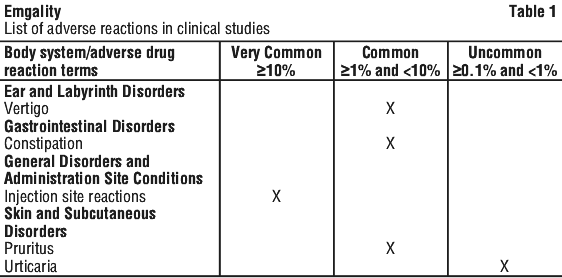 While the data are limited for a comprehensive assessment of withdrawal and rebound effects, there is no evidence of such an effect based on review of migraine adverse events.
While the data are limited for a comprehensive assessment of withdrawal and rebound effects, there is no evidence of such an effect based on review of migraine adverse events.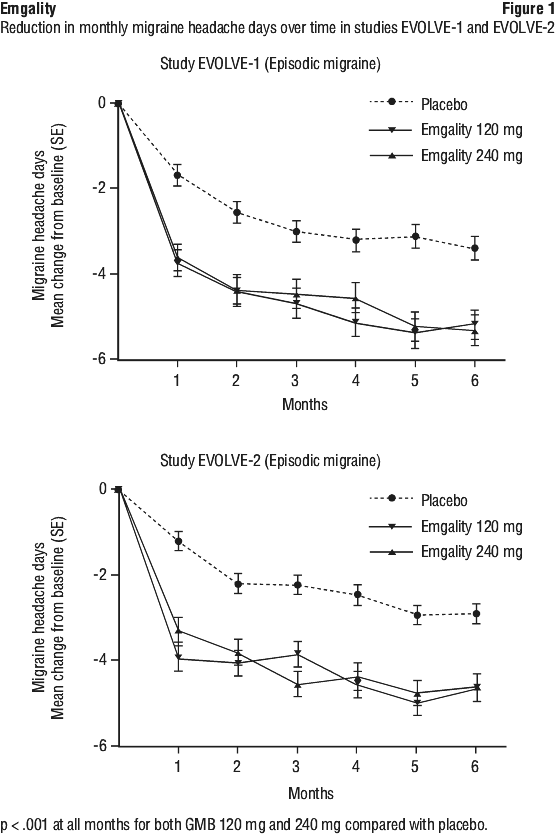
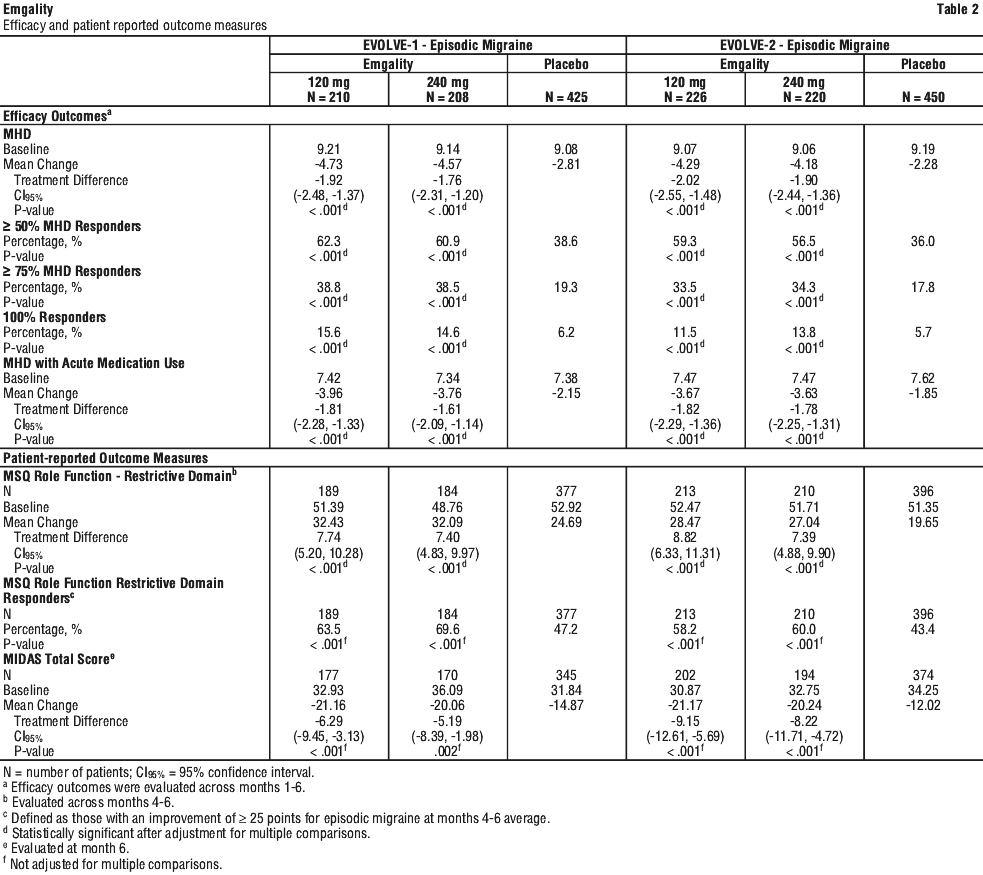 In pooled data from studies EVOLVE-1 and EVOLVE-2, in patients who failed one or more prophylactic treatments for efficacy reasons, the treatment difference for the reduction of mean monthly MHDs observed between galcanezumab 120 mg and placebo was -2.69 days (p < 0.001) and between galcanezumab 240 mg and placebo -2.78 days (p < 0.001). In patients failing two or more prophylactic treatments, the treatment difference was -2.64 days (p < 0.001) between 120 mg and placebo and -3.04 days (p < 0.001) between 240 mg and placebo.
In pooled data from studies EVOLVE-1 and EVOLVE-2, in patients who failed one or more prophylactic treatments for efficacy reasons, the treatment difference for the reduction of mean monthly MHDs observed between galcanezumab 120 mg and placebo was -2.69 days (p < 0.001) and between galcanezumab 240 mg and placebo -2.78 days (p < 0.001). In patients failing two or more prophylactic treatments, the treatment difference was -2.64 days (p < 0.001) between 120 mg and placebo and -3.04 days (p < 0.001) between 240 mg and placebo.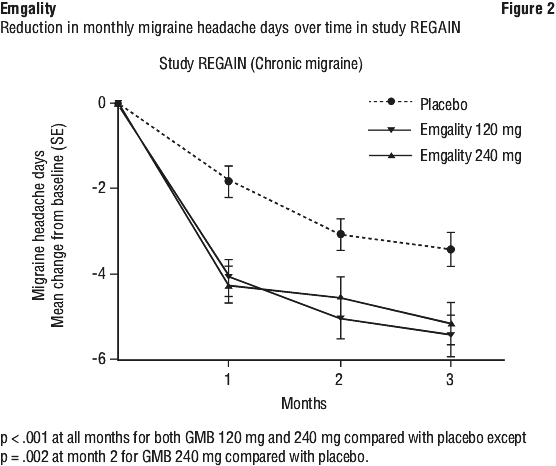
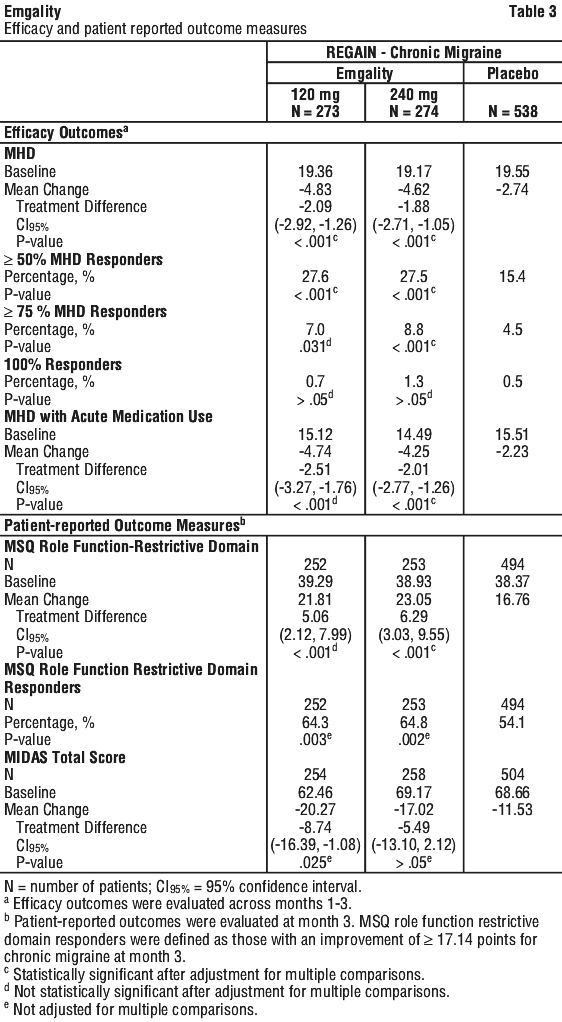 In patients who failed one or more prophylactic treatments for efficacy reasons, the treatment difference for the reduction of mean monthly MHDs observed between galcanezumab 120 mg and placebo was -3.54 days (p < 0.001) and between galcanezumab 240 mg and placebo -1.37 days (p < 0.05). In patients failing two or more prophylactic treatments, the treatment difference was -4.48 days (p < 0.001) between 120 mg and placebo and -1.86 days (p < 0.01) between 240 mg and placebo.
In patients who failed one or more prophylactic treatments for efficacy reasons, the treatment difference for the reduction of mean monthly MHDs observed between galcanezumab 120 mg and placebo was -3.54 days (p < 0.001) and between galcanezumab 240 mg and placebo -1.37 days (p < 0.05). In patients failing two or more prophylactic treatments, the treatment difference was -4.48 days (p < 0.001) between 120 mg and placebo and -1.86 days (p < 0.01) between 240 mg and placebo.